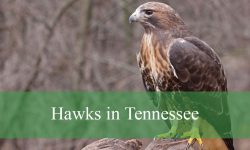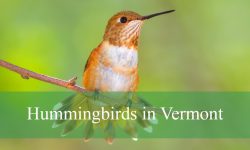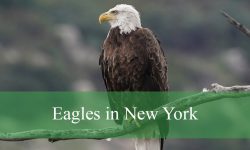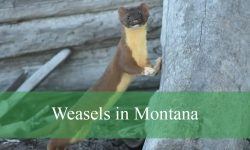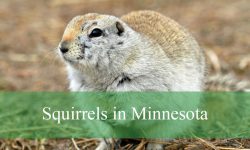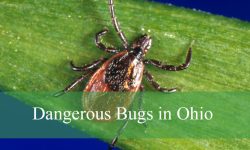In the world of birds, black and white birds are a sight to behold due to their eye-catching, bright, and contrasting plumage patterns. A wide variety of black and white birds, including woodpeckers, warblers, owls, and shorebirds, can be found in North America.
In this article, we will look at some of the most prevalent and fascinating black-and-white birds in North America.
Different Types of Black and White Birds
Black-Bellied Plover
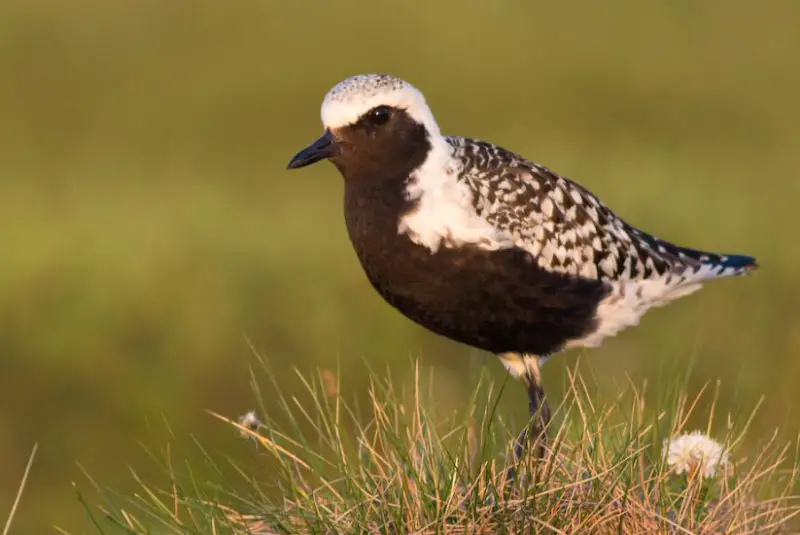
During breeding season, the Black-bellied Plover (Pluvialis squatarola) displays a striking black and white appearance. Outside breeding, males are white and dark gray, resembling juveniles. Often seen individually or in flocks along coastlines, they have a global distribution, from North America and Europe to Northern Asia and Arctic regions.
Found primarily in tundra habitats, they rarely venture inland, preferring coastal areas from North America to the Arctic and throughout Europe.
Black-And-White Warbler
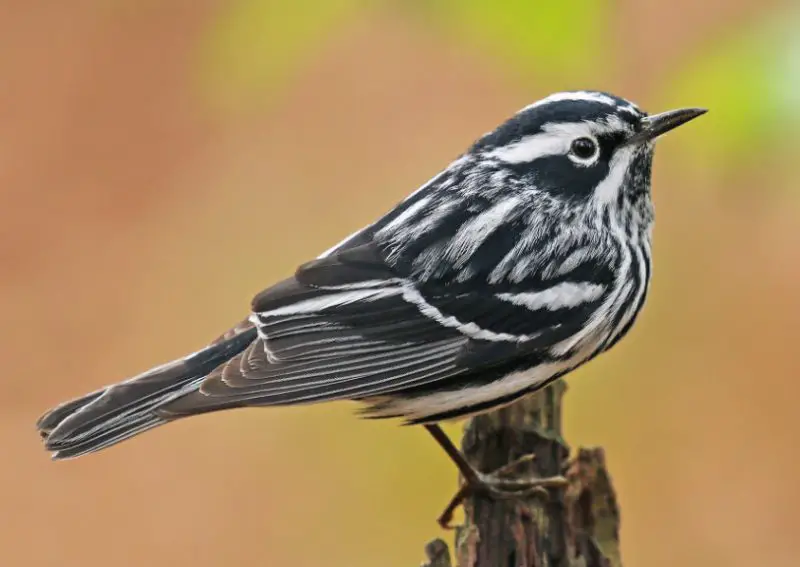
The Black-and-white Warbler (Mniotilta varia), sized between 4 and 5 inches, showcases distinctive black and white streaks on its head, body, and wings. Both males and females display this pattern, with slight variations such as gray or brown spots on the female’s belly or face.
Found across Eastern and Central Canada, the Eastern United States, Southern Florida, Central America, and Colombia, they migrate from Northern North America to tropical and subtropical regions for winter.
Greater Yellowlegs
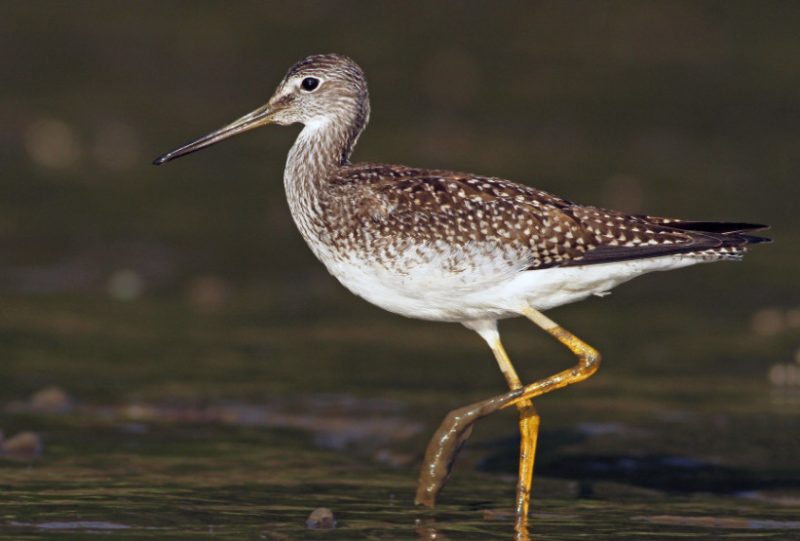
During breeding season, the Greater Yellowlegs (Tringa melanoleuca) displays black and white plumage, complemented by its distinctive long yellow legs.
Found in boreal forests across Northern North America, they migrate South for winter, reaching as far as Argentina or the coasts of North America.
Breeding occurs in wet areas concealed within dense vegetation, typically in the same regions where they feed. Distributed across Canada, the United States, Central, and South America.
Common Goldeneye
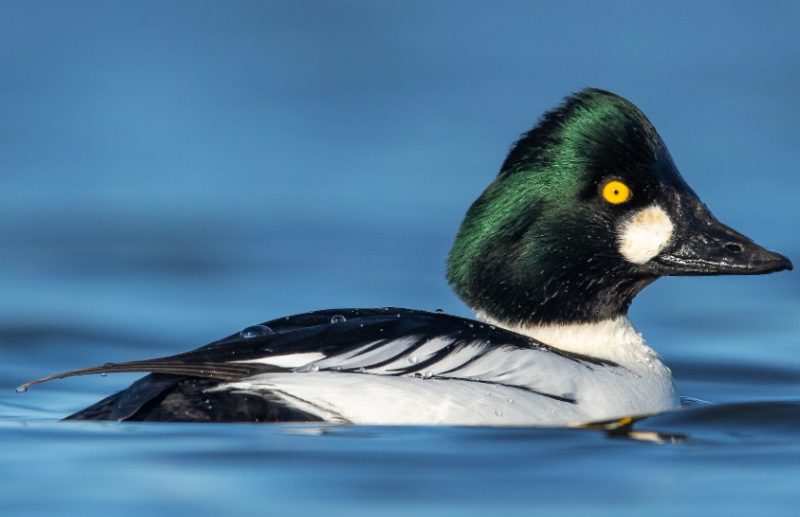
The male Common Goldeneye (Bucephala clangula) stands out with its black and white contrast, complemented by a metallic green head. Females have a dark brown head, gray and white plumage, and a yellow-tipped black beak.
Found in boreal forests of North America and Asia, they favor lakes and waterways for underwater foraging, feeding on crustaceans. Once settled, they become territorial. Distributed across North America, Northern Europe, and Northern and East Asia.
American Avocet
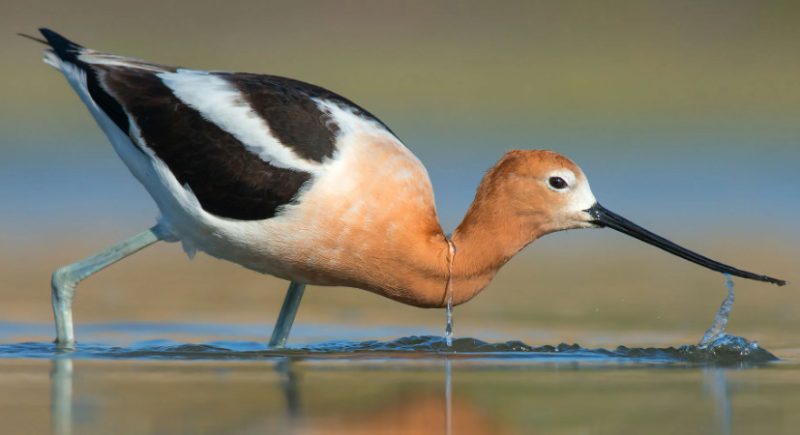
During the breeding season, the American Avocet (Recurvirostra americana) displays striking black, yellow, and red plumage. Their head and neck turn bright red while their underbelly and wings remain black and white.
Found along the Eastern coast of North America, particularly in Eastern Canada, the Eastern United States, and the Gulf of Mexico, they favor areas with shrimp, a favorite food source.
Nuttall’s Woodpecker

The Nuttall’s Woodpecker (Dryobates nuttallii) stands out with its black and white plumage, featuring white wing bands and a black-and-white head. Males may have red crowns.
Exclusive to California, they thrive in diverse woodlands across the state, laying clutch sizes of a few eggs in cavities. Despite their limited distribution, they maintain stable populations throughout California’s woodlands.
Black-Billed Magpie

Black-billed Magpies (Pica hudsonia) sport a striking combination of black, white, and blue plumage, with iridescent blue sections on their bodies. Their long black tails are notably one of the longest relative to body size in the United States and Canada.
Found in Western North America, particularly around farms and open areas, they reach sizes of up to 24 inches and have a diverse diet ranging from fruits and seeds to carrion and acorns.
Heermann’s Gull
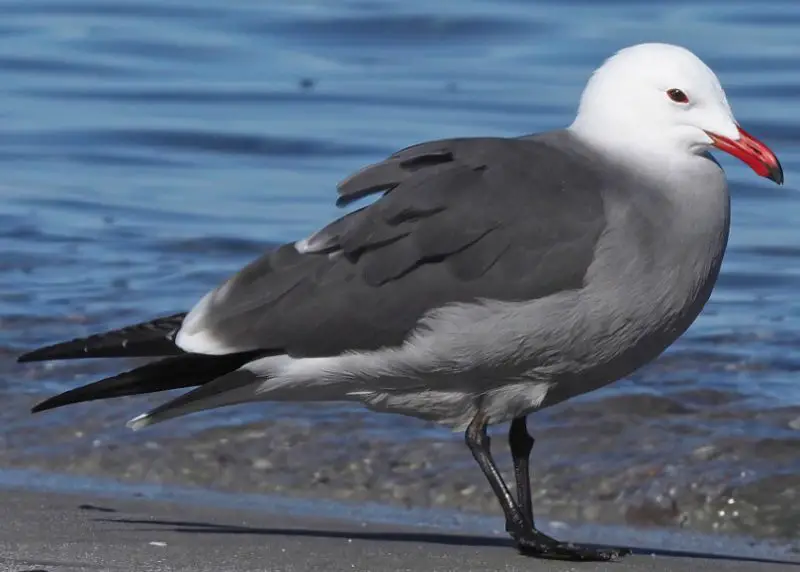
Heermann’s Gulls (Larus heermanni) exhibit a striking appearance with white heads, black and gray wings, and bright gray bellies, accentuated by red beaks.
They frequent the Gulf of California and the West Coast, feeding on coastal fare like small fish and insects. Often observed in large, aggressive flocks, they nest on the ground in colonies, laying eggs in coastal regions.
Great Black-Backed Gull
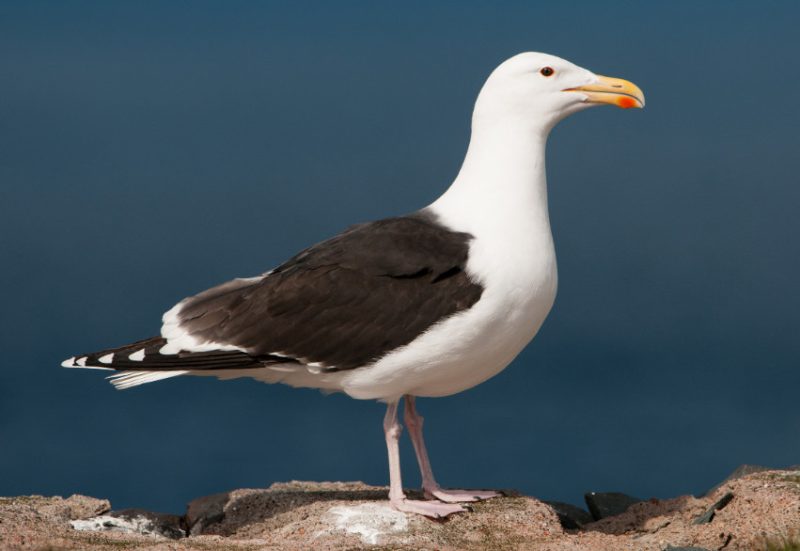
Great Black-backed Gulls (Larus marinus) are the world’s largest gulls, reaching up to 31 inches. With mostly white bodies and gray and black wings, they have yellow-orange or dark-orange beaks.
Found in coastal areas, they are opportunistic feeders, consuming fish, carrion, and more. While some are resident, many migrate for winter, crossing the Atlantic Ocean effortlessly. Distributed across the Eastern US, Greenland, Iceland, and Northern Europe.
Common Eider
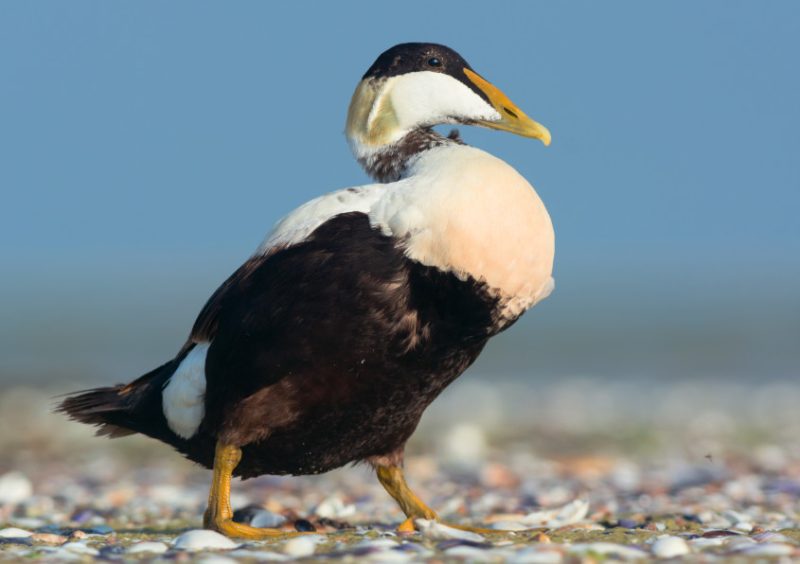
The male Common Eider (Somateria mollissima) features a black crown, white body, and black wings, while females have dull brown-gray coloring. Among the largest ducks globally, they inhabit coastal colonies, sometimes numbering hundreds or thousands.
They exhibit social living, with females cooperating to raise young ducks, even laying eggs together. Found along Canadian and Alaskan coastlines and Northern Europe.
Downy Woodpecker
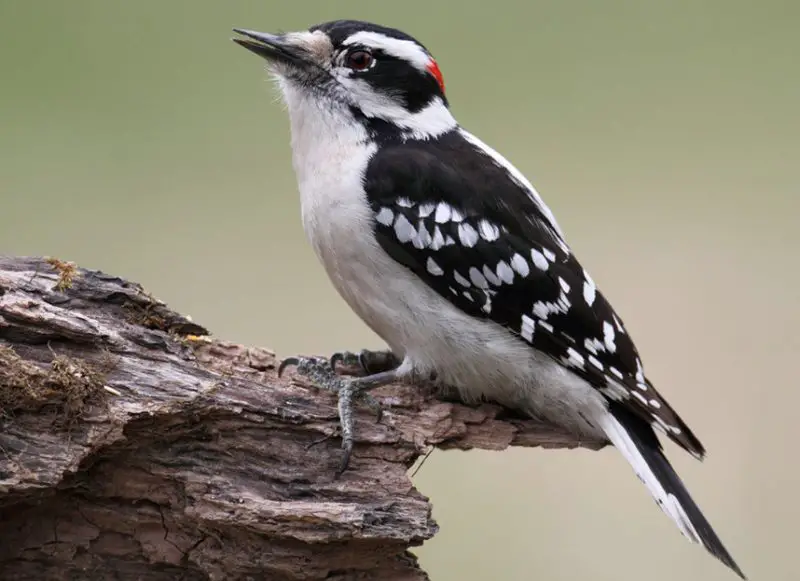
The Downy Woodpecker (Dryobates pubescens) is a common sight across North America, showcasing its distinctive black and white plumage with a vibrant red crown. Males sport a striking red cap, while females exhibit a black crown.
Their white-spotted tails and black beaks further distinguish them. Some migrate south for winter, particularly those in northern regions and high altitudes. Found throughout Alaska, Canada, and the United States, these woodpeckers are known for their diverse vocalizations and adaptability.
Black-Crowned Night-Heron
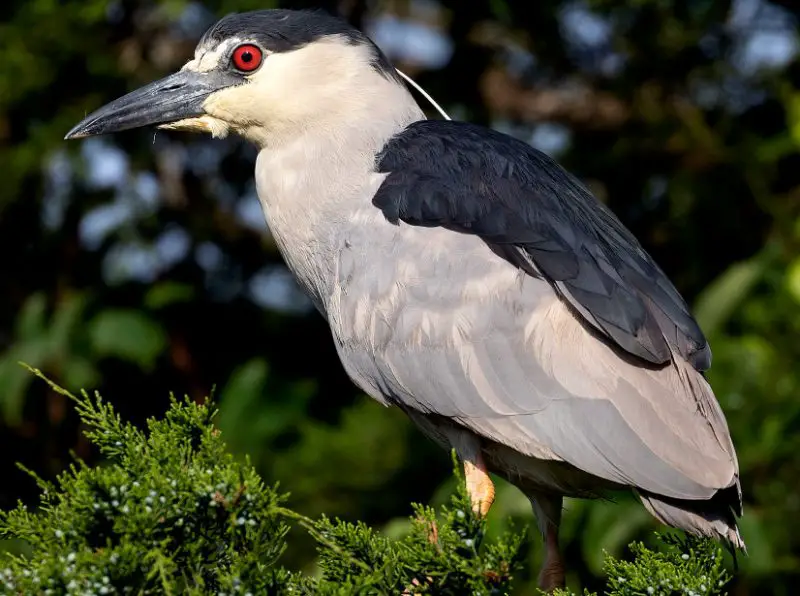
The Black-crowned Night-Heron (Nycticorax nycticorax) is a globally distributed bird, identified by its namesake black crown atop a white and gray body. Known for its diverse feeding strategies, it frequents water bodies, preying on fish using patience or even live bait.
This adaptable species can be found across the Americas, Europe, Africa, and Southeast Asia, with some populations migrating, particularly those in northern regions.
Carolina Chickadee
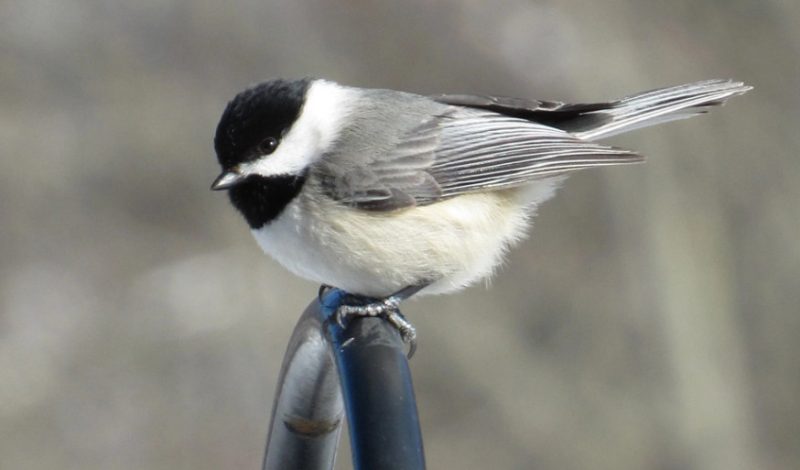
The Carolina Chickadee (Poecile carolinensis) boasts a distinctive black, white, and cream plumage, with a black-capped head, white chest, and cream or bright yellow belly. Found across the Eastern and Southeastern United States, it’s a resident species, avoiding overwintering migrations. In colder climates, they nest in tree cavities for warmth.
Their diet consists mainly of insects and seeds, and they exhibit agile foraging behaviors, often seen traversing trees and even hanging upside down to find food.
Black-Capped Chickadee
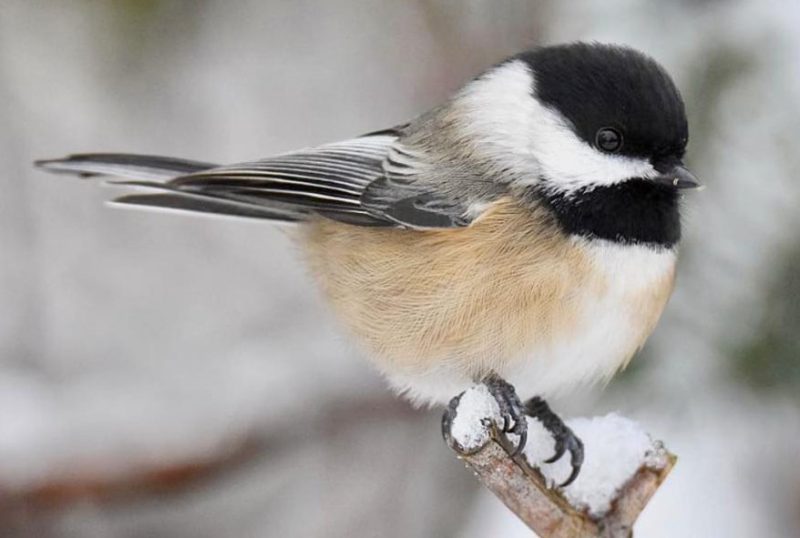
The Black-capped Chickadee (Poecile atricapillus) shares similarities with the Carolina Chickadee, sporting a black and white head with a black crown and neck. Its distinctive features include a white-sided head, yellow belly, and gray wings.
Found in diverse forest habitats across Alaska, Canada, and the northern United States, they excel at regulating body temperature in winter. Their diet comprises various caterpillars and insects gleaned from trees.
Western Gull
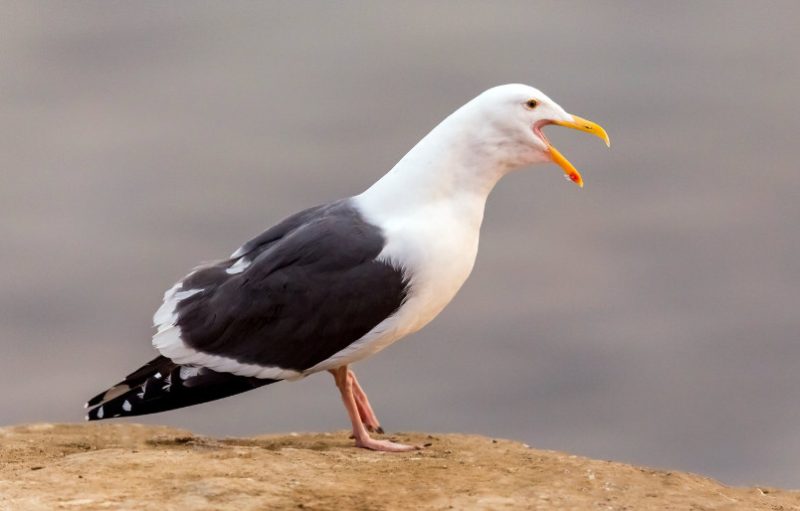
The adult male Western Gull (Larus occidentalis) boasts a striking black and white plumage. Native to the United States, particularly the West Coast, it rarely strays far inland, preferring coastal habitats.
With a wingspan reaching up to 27 inches, it frequents California, Washington, and Oregon, though only the northernmost and southernmost populations undertake seasonal migrations, often overwintering in regions like Baja California.
Laughing Gull

Laughing Gulls (Leucophaeus atricilla) feature black heads, wings, tails, and red-brown beaks, while young ones exhibit varying shades of bright gray. Maturing to about 15 inches, they acquire their distinctive black and white appearance as adults, which takes several years.
Found along the Eastern Coast of North America to the Northwestern Coast of South America, Laughing Gulls inhabit regions spanning from Southeastern Canada to Ecuador, including the US East Coast, the Caribbean, Central America, Colombia, and Ecuador.
Bufflehead
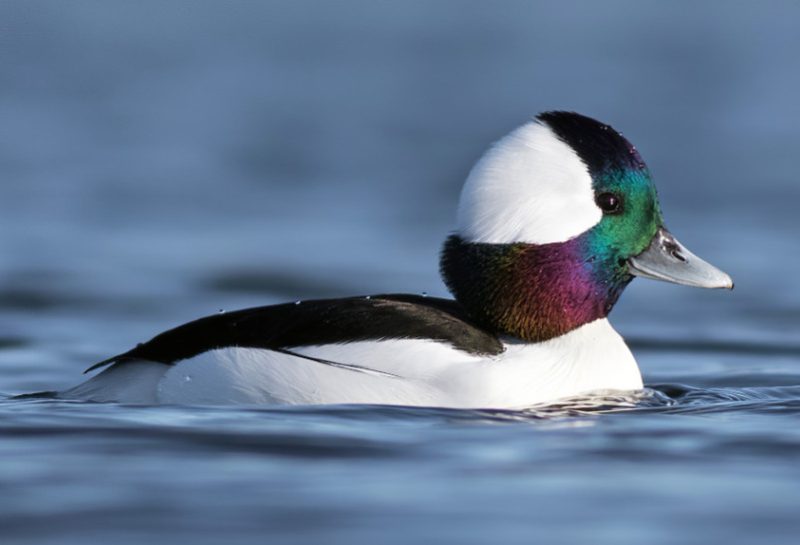
The Bufflehead (Bucephala albeola), a sea duck native to North America, showcases a striking black and white plumage, particularly in males. Males sport a black and white head with a green face, while females exhibit various shades of gray.
Found around saltwater, they feed on crustaceans and plants. Their distribution spans Canada, the United States (including Alaska), and Mexico, with some northern individuals migrating to the Great Lakes for winter.
Ring-Necked Duck
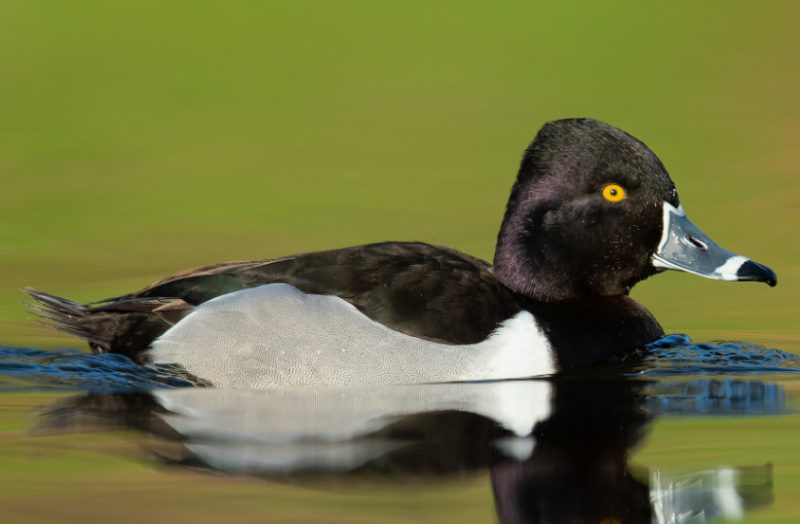
The Ring-necked Duck (Aythya collaris) males exhibit a striking black and white coloration, reaching sizes of up to 18 inches. During their early stages, they feed on leeches or snails before transitioning to omnivores, consuming plant matter as adults.
While some migrate to Southern states, Central America, or even Western Europe for winter, not all individuals migrate annually. They are found across Canada, the Northern, Western, and Southern United States, and Mexico.
Acorn Woodpecker
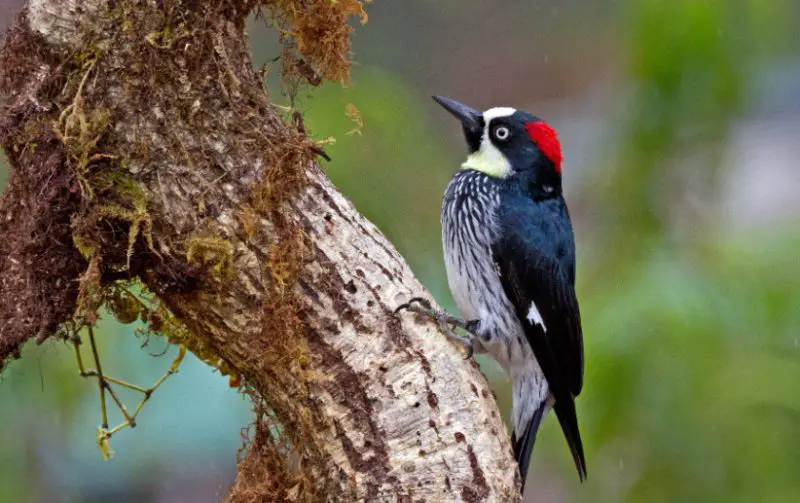
The Acorn Woodpecker (Melanerpes formicivorus) is exclusive to the Southwestern United States and Mexico. Named for their primary diet of acorns, they grow up to 8 inches in size and sport distinctive black and white plumage with red crowns.
Often found in California, they nest in the fall, aligning with the abundance of acorns. While acorns are their main food source, they also consume insects and other foods.
Black-Necked Stilt
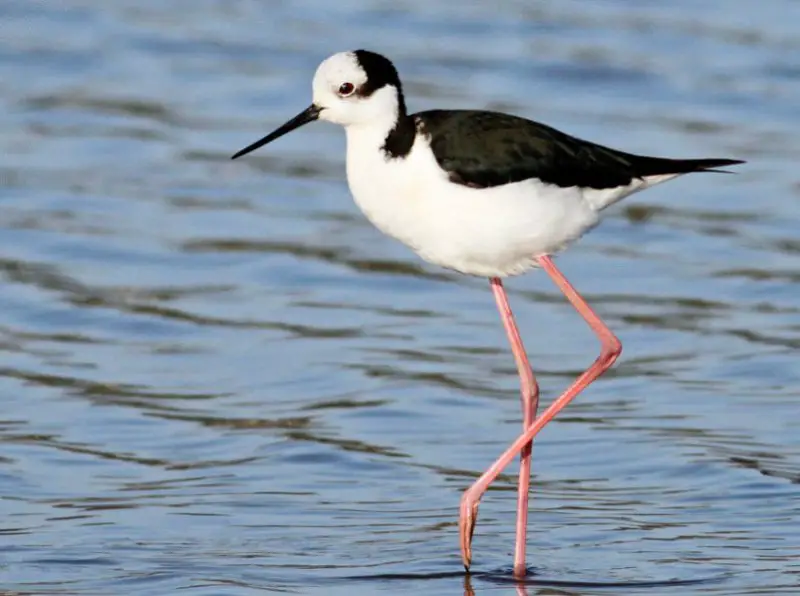
The Black-necked Stilt (Himantopus mexicanus) measures up to 15 inches, sporting black and white plumage with distinctive pink legs. Their heads are black and white, while their bellies are white and wings are black.
Found in wetland habitats across the Americas, particularly in shallow waters, they frequent areas like the San Joaquin Valley and the Colorado River in North America. They’re also prevalent in Southern Mexico and South America, spanning regions from California and Arizona to Cuba, Panama, and Brazil.
Common Merganser
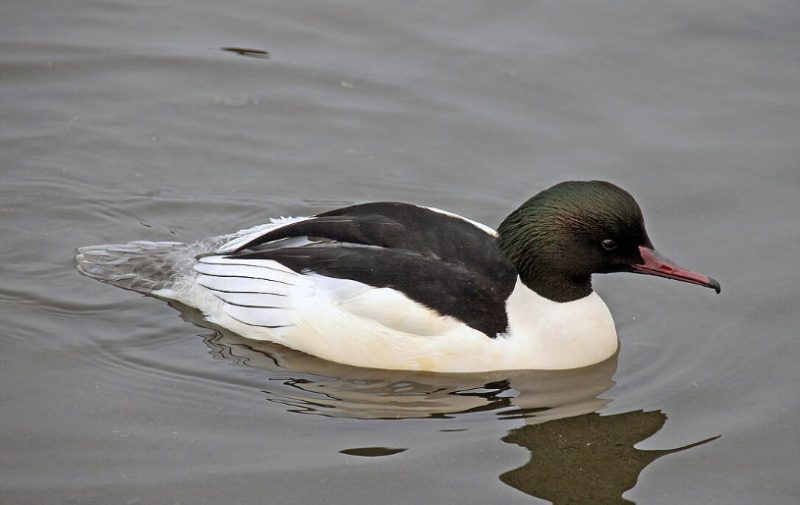
The Common Merganser (Mergus merganser americanus) features a striking black and white plumage in males, with a distinctive long, red-brown, curved beak. Their wings are predominantly white and black, contrasting with a white underside. Females display brown heads, gray wings, and a crown. With serrated beak edges, they adeptly grip crustaceans.
Found across North America, Europe, and parts of Asia, they undertake short migrations to avoid frozen water surfaces during winter.
Hairy Woodpecker

The Hairy Woodpecker (Dryobates villosus) exhibits a classic black and white plumage with some variations in belly coloration. Males are distinguished by their red crowns, also present in juveniles.
Found in woodlands across the Americas, they feed on insects extracted from tree bark and consume small fruits. Their distribution spans from Canada and Alaska to the United States and Mexico.
Eastern Kingbird

Eastern Kingbirds (Tyrannus tyrannus) native to North America, migrate to South America and occasionally Europe. With black heads, gray wings, and white bodies, they hunt insects mid-flight, occasionally feeding on seeds and fruit.
Found in shrubs and small trees, they nest and forage across Canada, the United States (except the Southwest), Southern Mexico, Panama, Guatemala, Colombia, Venezuela, and Brazil.
Common Loon
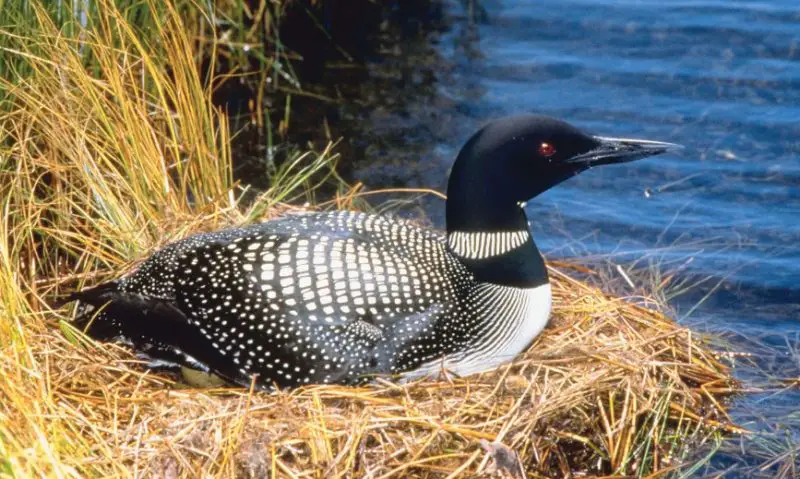
During the breeding season, the Common Loon (Gavia immer) dons a striking black and white appearance with a glossy green-black head. Outside breeding, it’s mostly gray and white. Found in water bodies across the Northern Hemisphere, it undergoes multiple appearance changes as it matures, culminating in a permanent gray and white plumage.
It’s most easily identified during breeding season when males and females remain together. Distributed across North America, Greenland, Iceland, and Northern Europe.
Lesser Scaup
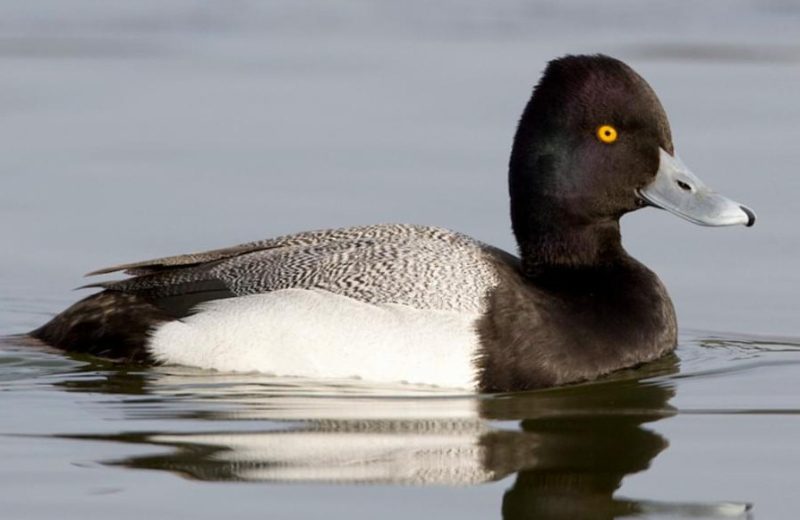
During breeding, adult male Lesser Scaups (Aythya affinis) display a striking black and white plumage with a glossy green-black head. Females feature a brown and chestnut coloration. Found near lakes, ponds, and marshes, they nest on the ground.
While some migrate, populations around the Great Lakes and the Rockies are year-round residents. Distributed across Alaska, Western and Central Canada, the United States, the Caribbean, and Central America.
Rose-Breasted Grosbeak

The Rose-breasted Grosbeak (Pheucticus ludovicianus) derives its name from the male’s red chest and black head, complemented by black and white wings and a white underbelly. Females are predominantly brown.
Found in North American woodlands, they embark on a long migration to overwinter in tropical regions of South America before returning. Distributed across Canada, the Eastern United States, Mexico, Cuba, Guatemala, and Panama.
Long-Tailed Duck
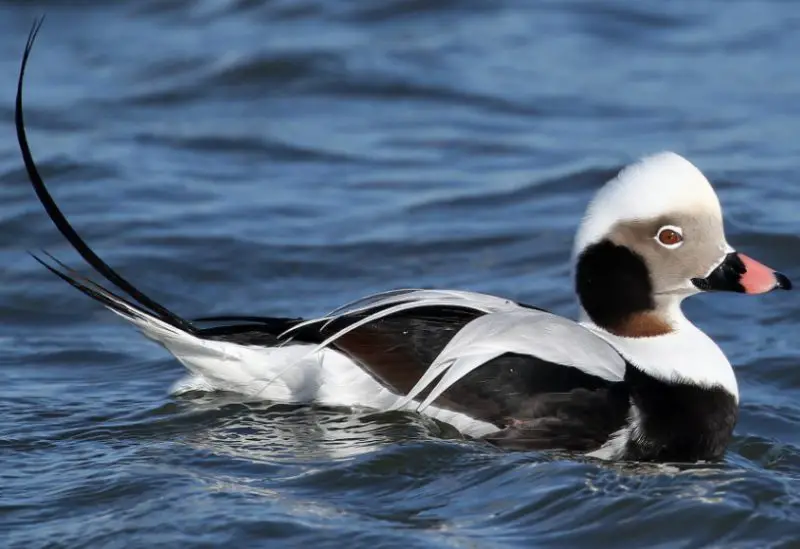
Named for their distinctive tails, Long-tailed Ducks (Clangula hyemalis) feature bright white and black plumage in males and brown coloring in females. Found along cool coastlines of the Northern Hemisphere, they excel at diving for crustaceans, capable of diving hundreds of feet.
While some populations migrate, overwintering occurs along warmer coastlines. Males molt from white to gray heads during winter. Distributed across Alaska, Northern Canada, Greenland, Europe, and Northern Asia.
Bobolink
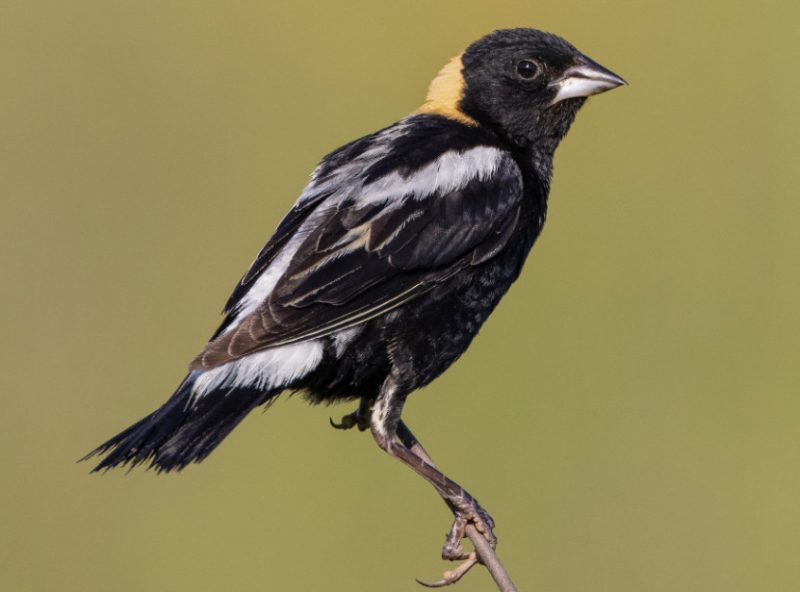
Bobolinks (Dolichonyx oryzivorus) are often considered pest birds across the Americas due to their tendency to feed on grains. Growing up to 8 inches, males sport black and white stripes while females are brown-gray.
Known for long-distance migration, North American populations travel to South America for winter. They frequently rest in open fields and crops along their busy migration routes. Distributed across Southern Canada, Northern US, and South America.
Lesser Black-Backed Gull
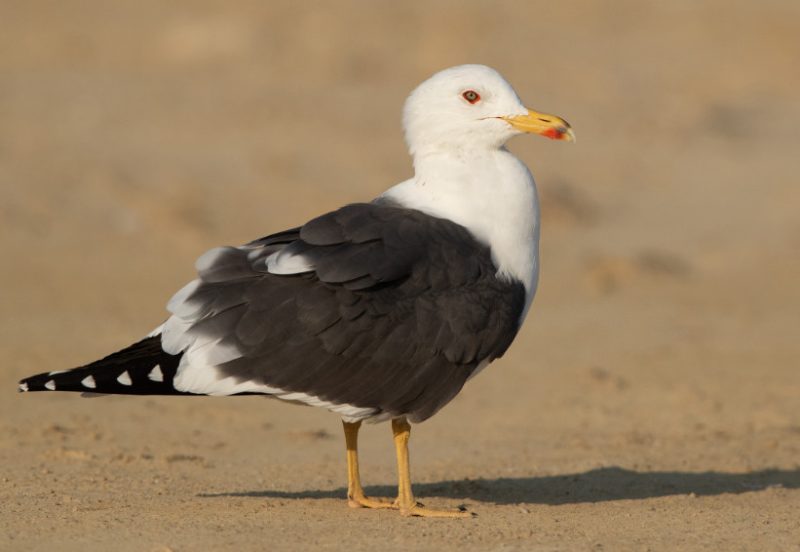
Adult male Lesser Black-backed Gulls (Larus fuscus) exhibit white, black, and gray plumage, with white heads and underbellies and gray-black wings. Found in coastal areas worldwide and around lakes, they have an omnivorous diet, including earthworms, mollusks, fruits, and carrion.
While mostly absent from North America, they’re occasionally spotted on the East Coast, particularly in coastal overwintering colonies. Distributed across the Gulf of Mexico, North America’s East Coast, Europe, Africa, Northern and Southern Coastal Asia, and East Asia.
Pigeon Guillemot
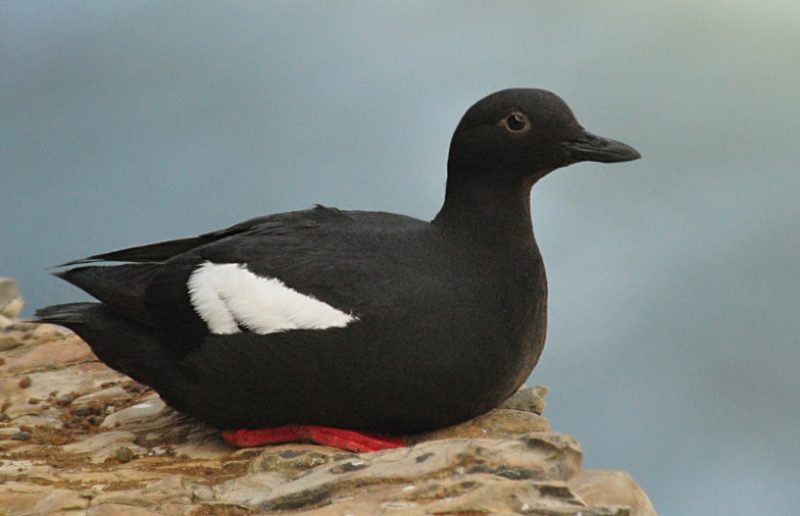
Pigeon Guillemots (Cepphus columba) are coastal birds found along North America’s West Coast. Males display dark plumage with black and dark brown colors, white wings, and red legs. Living in small numbers, they forage for marine invertebrates near the water’s surface.
While some migrate for winter, they typically remain within their coastal range, spanning Western and Southern Alaska, Western Canada, and the US West Coast.
Black-Throated Gray Warbler
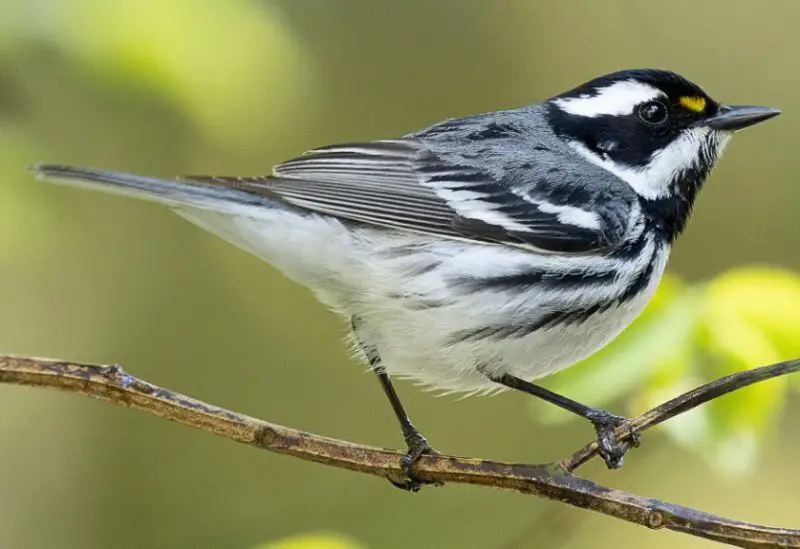
The Black-throated Gray Warbler (Setophaga nigrescens) derives its name from the black and white coloration on its head and neck. While its wings may be brown, they are less noticeable compared to its striking head pattern.
Found in various habitats, from oak woodlands to chaparral, these birds are commonly seen even in inhabited areas. Their distribution spans the Eastern US, Mexico, and Baja California.
Surf Scoter
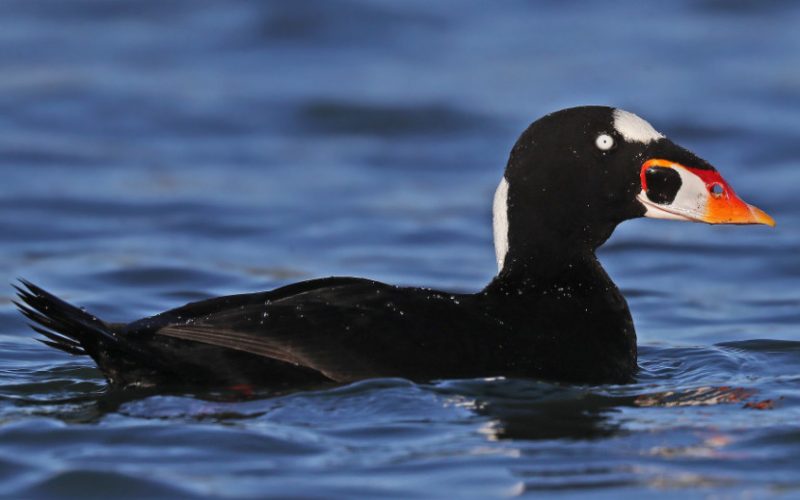
The Surf Scoter (Melanitta perspicillata), predominantly black with white patches on the crown and behind the head, features a distinctive yellow, black, and white beak in males. Females exhibit mottled gray and brown coloring. Males are consistently larger than females, with a size difference of around 2 inches. They also initiate breeding and have lower-pitched vocalizations compared to females.
Found along the coasts of Alaska, Canada, and the US East and West Coasts.
Clark’s Grebe

Clark’s Grebe (Aechmophorus clarkii) dons striking black and white plumage during breeding season. Both genders sport contrasting colors, featuring a black crown and striking red eyes.
Preferring bodies of water, they inhabit the Pacific Coast, lakes, and the Colorado River, favoring wooded areas. Their range spans the Western and Southwestern United States, extending into Mexico.
Swallow-Tailed Kite
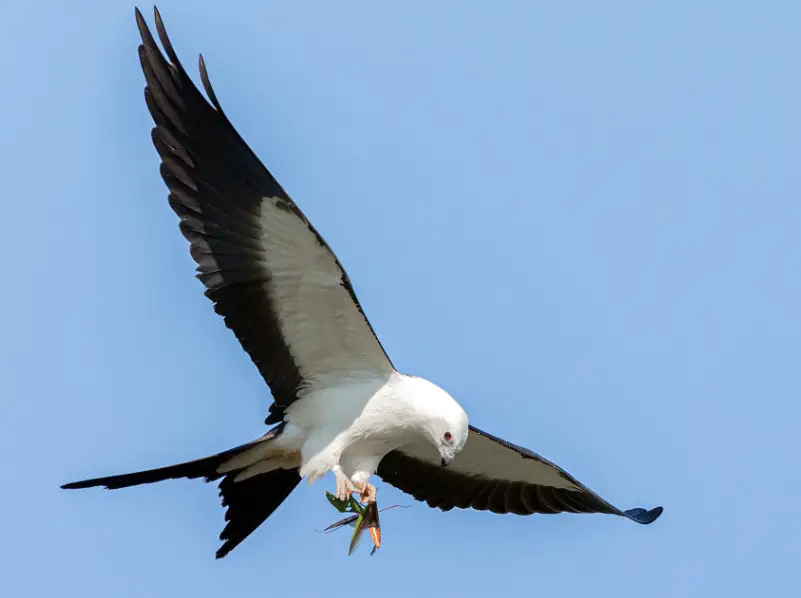
The Swallow-Tailed Kite (Elanoides forficatus) is a migratory bird found across North and Central America, wintering primarily in South America. It thrives in regions with temperate climates and moist forests.
Recognizable by its distinctive forked tail, it boasts a white head, black and white wings, and a white body. Predatory habits include hunting small reptiles and mammals. Its range spans the Gulf of Mexico and South America.
Barrow’s Goldeneye
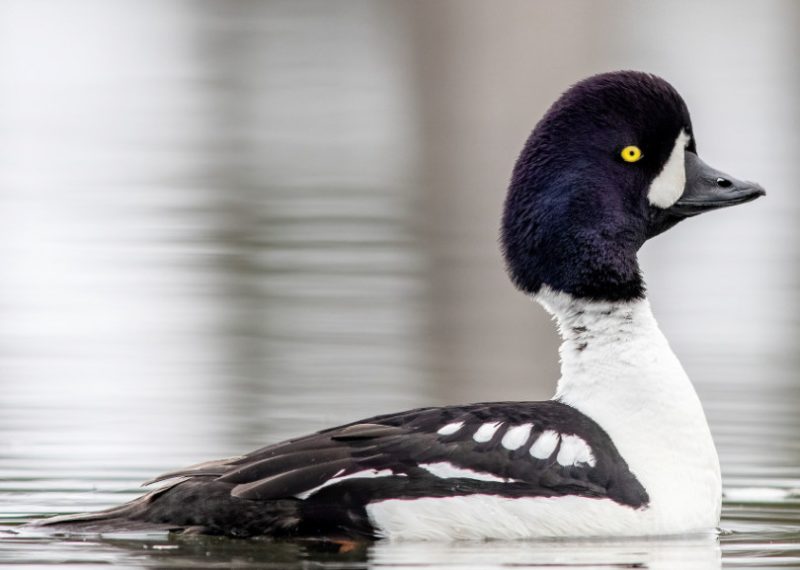
Barrow’s Goldeneye (Bucephala islandica) primarily inhabit forested lakes, displaying distinctive black and white plumage in males. Females are predominantly chestnut brown and gray, with black heads and white cheeks.
While they can be found along coastlines, they are less vocal, reserving their calls for breeding. Some may migrate for breeding purposes. Their distribution spans Eastern North America.
Yellow-Billed Magpie
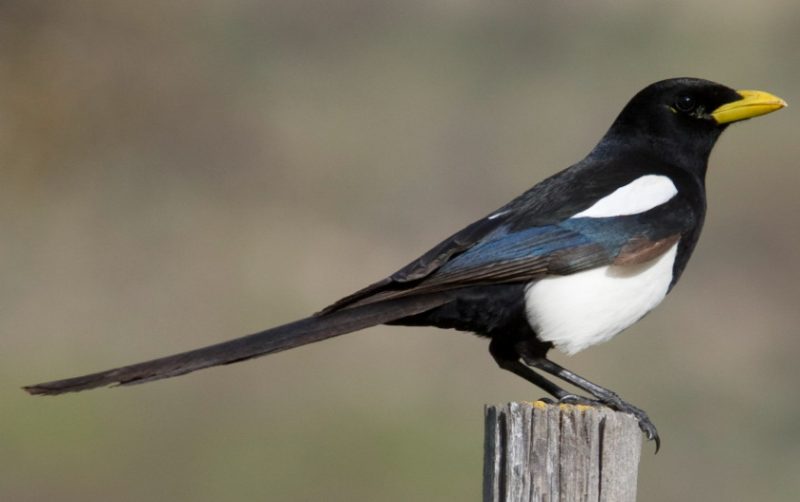
The Yellow-Billed Magpie (Pica nuttalli) stands out with its vibrant yellow beak, black head, and green wing streaks. Sporting a predominantly black body, its wings and tail feature green accents, while the underbelly and wing bases are white.
Found mainly in California’s Central Valley, they thrive in hot summers. Notably, they exhibit a unique ritual of gathering around deceased members.
Lark Bunting
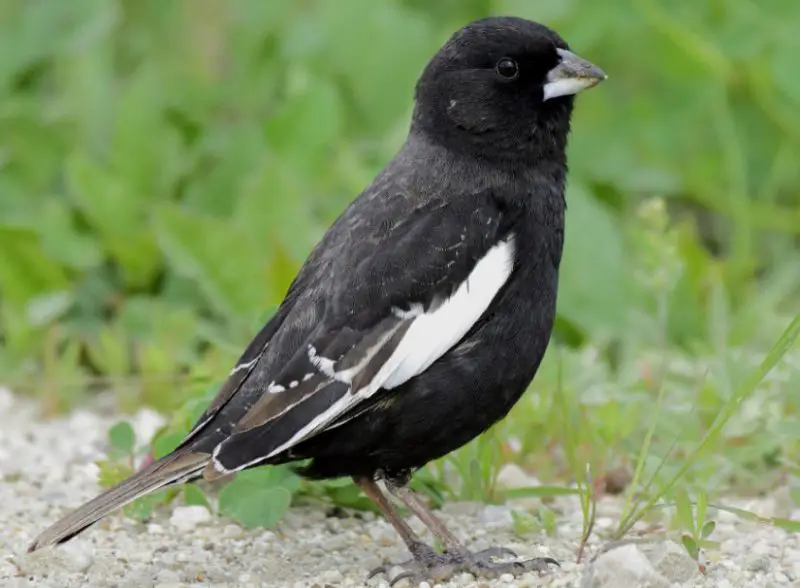
Male Lark Buntings (Calamospiza melanocorys) exhibit predominantly black plumage with minimal white markings, notably along the wings, and a distinctive black-and-white beak. In contrast, females are mainly gray, highlighting the significance of coloration in mate selection.
Females opt for males with varying black-and-white ratios annually, ensuring genetic diversity in breeding. This selective process spans across their distribution in the United States and Mexico.
Red-Cockaded Woodpecker
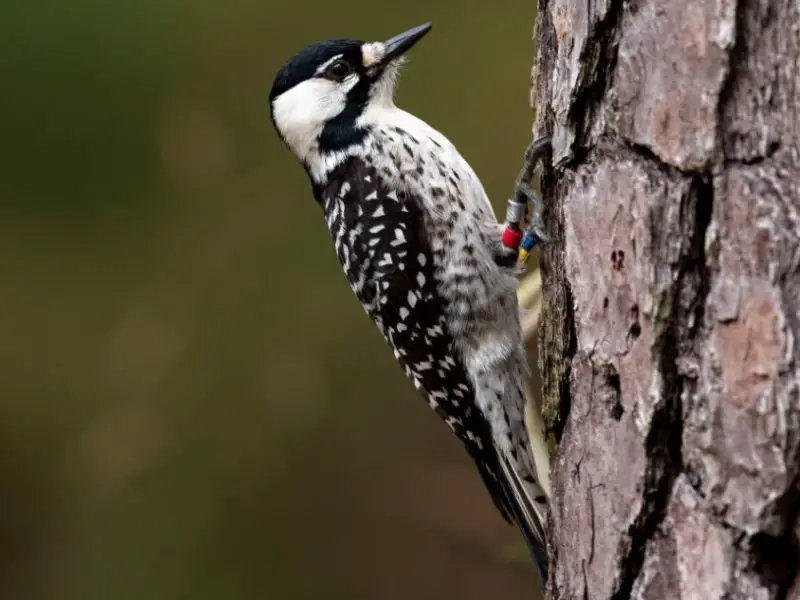
The Red-Cockaded Woodpecker (Dryobates borealis) is distinguished by red streaks on the male’s head, contrasting with a black crown and white cheeks. Females lack the red markings but share habitats with males, typically residing in pine forests across the Southeastern US.
They prefer pine trees, where they may dwell for up to three years or longer.
Pin-Tailed Whydah
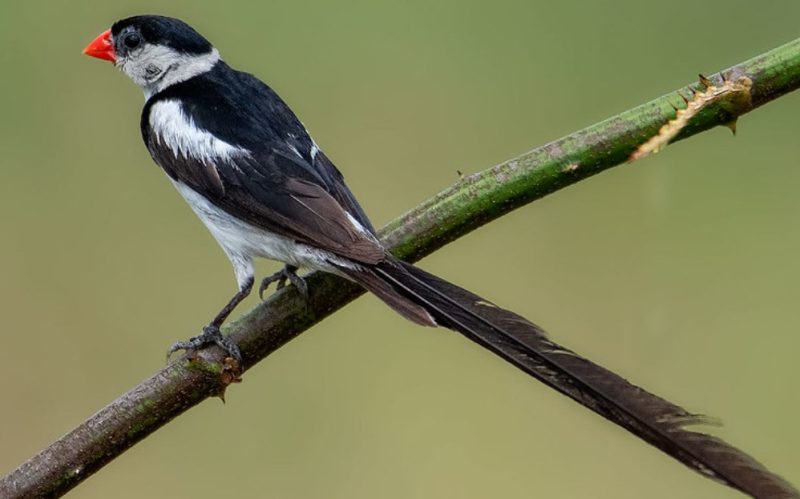
The Pin-Tailed Whydah (Vidua macroura), native to Africa, boasts a striking black and white plumage, with males featuring long black tails and red or orange bills. Females are gray and brown, lacking the distinctive tails.
Known as a brood parasite, they lay up to four eggs in the nests of other bird species, found across sub-Saharan Africa, often displacing other nest occupants.
Black Guillemot
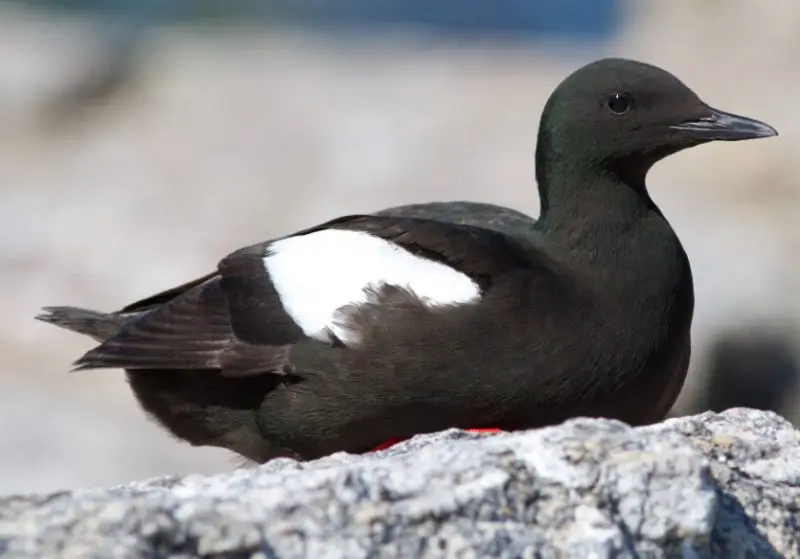
The Black Guillemot (Cepphus grylle) inhabits northern coastal regions, displaying black plumage with white wings or dark gray hues outside of breeding. Notably, they breed in coastal Iceland and migrate southward for winter, returning for breeding.
Their distribution spans Eastern Canada, Greenland, Iceland, and Northern Europe.
Razorbill

Razorbills (Alca torda), coastal inhabitants of the Atlantic, feature distinctive black and white plumage, with a black head, black-and-white beak, and white belly. They exhibit unique breeding behaviors, with males sharing egg care duties and often forming lifelong bonds with a single partner. Females lay only one egg annually.
They are found in Eastern Canada and Northern Europe.
Thick-Billed Murre
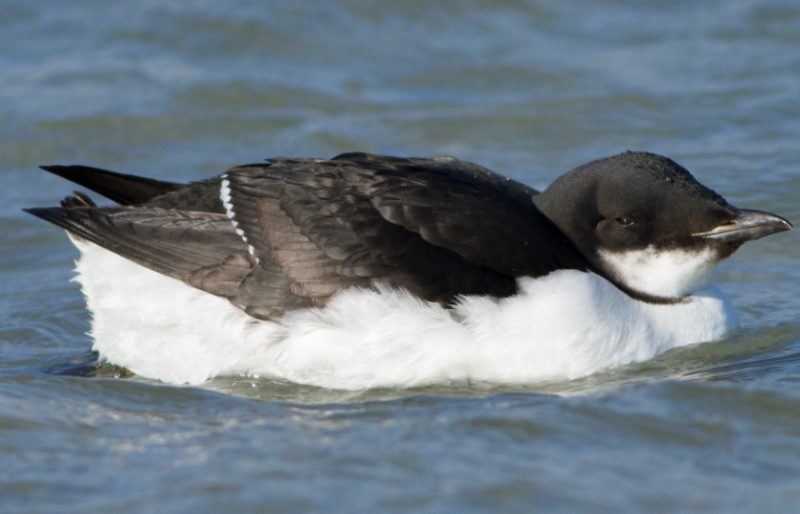
Adult Thick-Billed Murres (Uria lomvia) showcase striking black and white plumage, with black heads, bills, necks, and backs contrasting sharply with bright white underbellies. White stripes adorn the sides of their faces, leading to the bill.
These auks spend most of their lives at sea, only congregating on shores during the breeding season, often forming colonies. They are distributed across the North Pacific and North Atlantic.
Sooty Tern
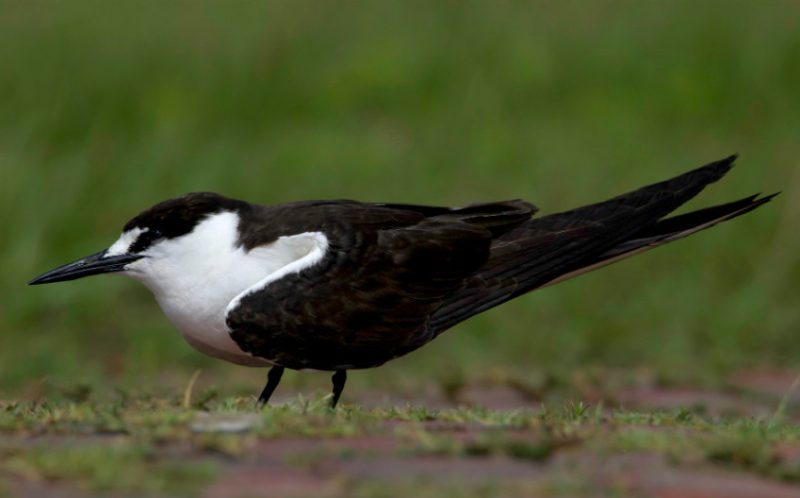
The Sooty Tern (Onychoprion fuscatus) is identified by its black and white head and elongated black beak, with black upper wings and white underwings. A migratory marine species, it winters in tropical regions.
During migration, hundreds or thousands of Sooty Terns fly together. They are primarily found in tropical regions.
Long-Tailed Jaeger
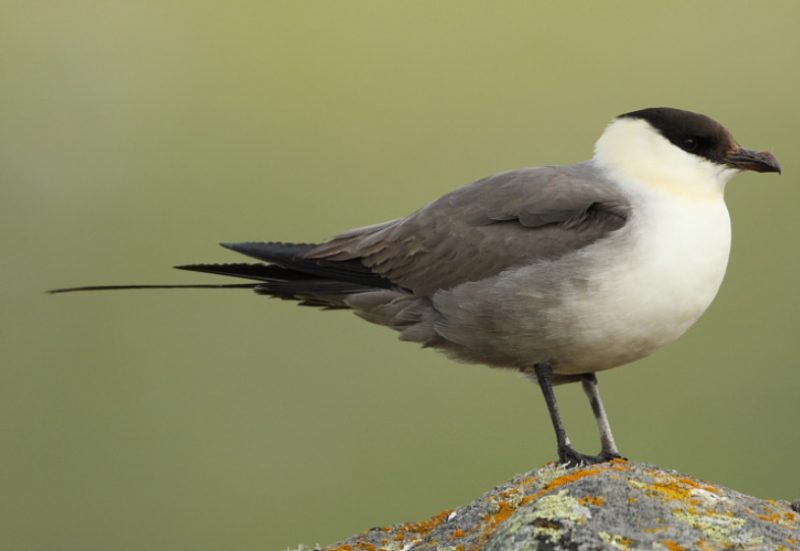
Breeding Long-tailed Jaegers (Stercorarius longicaudus) showcase a striking blend of black, white, yellow, and gray hues. Their black crown contrasts with yellow beaks and head sides. With white chests, gray wings, and long black tails, they’re adapted to Arctic tundra habitats.
Their low-pitched vocalizations echo across Northern Canada, Alaska, Greenland, and Siberia.
Barnacle Goose
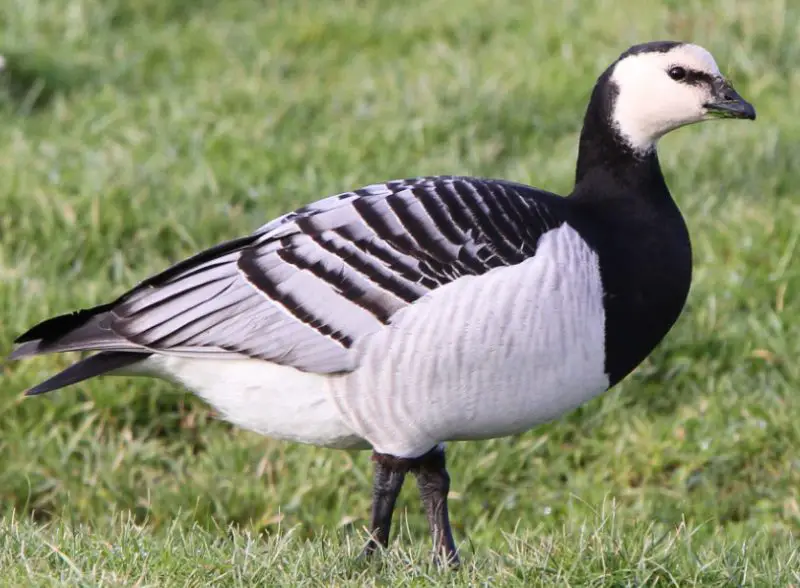
The Barnacle Goose (Branta leucopsis) reaches sizes from 22 to 28 inches, with females typically smaller. Both sexes exhibit a black and white pattern, with white heads, black crowns, and lateral stripes. Their necks and upper backs are black, while their bellies are white.
Found in Northern Europe, juveniles display uniform silver-gray plumage.
Masked Booby

The Masked Booby (Sula dactylatra) is distinguished by its black mask and white head, complemented by a short, wide yellow beak. Predominantly white, its wings display a mix of black and white.
Known for its fast flight, it inhabits warm waters across Oceania, the Indian Ocean, Pacific Ocean, and Atlantic Ocean. Breeding colonies are typically found in coastal areas.
Slaty-Backed Gull
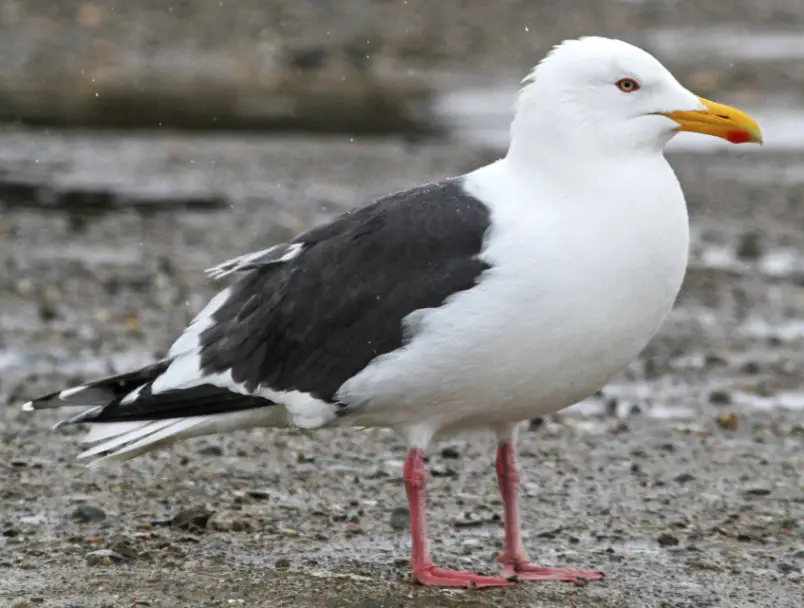
The Slaty-backed Gull (Larus schistisagus) displays a distinctive white head and black-and-white wings, achieved after several years of maturation. Juveniles exhibit dominant gray, brown, and white hues initially.
Primarily inhabiting the Western Pacific, with migrating populations also observed in Alaska, they boast a striking appearance in the Eastern Pacific.
Yellow-Footed Gull
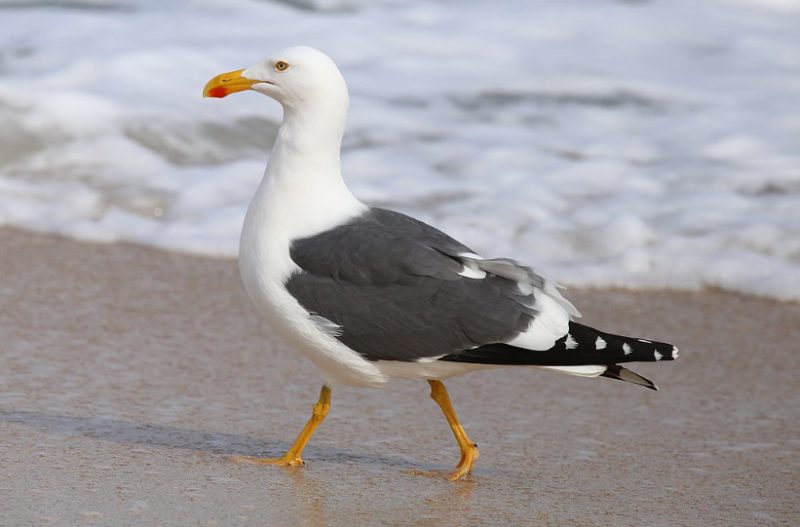
Yellow-Footed Gulls (Larus livens) are native to California, Baja California, and the Gulf of California. With a black and white body, their distinguishing feature is their contrasting yellow legs.
Growing up to 30 inches, they frequent coastal areas, especially sandy and rocky shores devoid of dense vegetation. They are commonly observed in California and Baja California.
Dovekie

During breeding season, Dovekies (Alle alle) transition from gray and white to striking black and white plumage. They feature black heads and necks, matching beaks and eyes, and black upper backs. Their wings display a mix of black and white, while the underbelly is entirely white.
These adept divers forage underwater for food. They are found in Northeastern Canada, Greenland, Iceland, and North Europe.
Parakeet Auklet
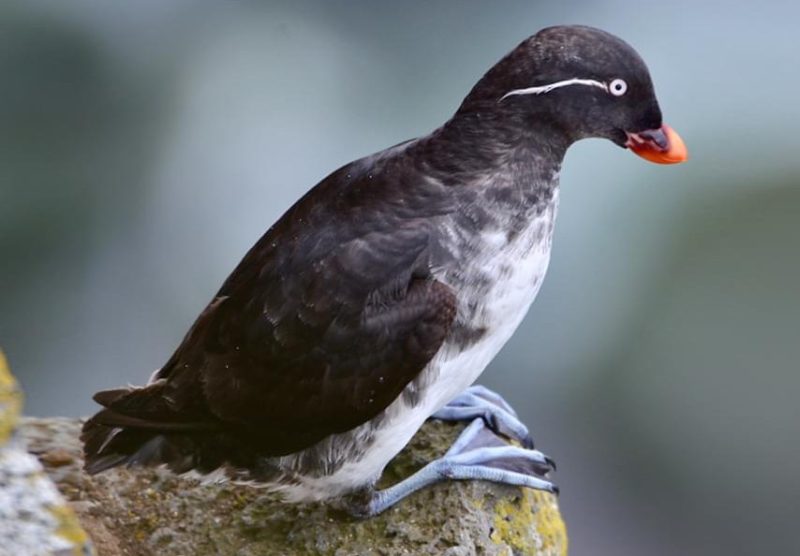
Parakeet Auklets (Aethia psittacula) breed in coastal areas and cliffs across the Northern Pacific. They sport mostly black plumage with a white underbelly and an orange beak. Their appearance remains consistent throughout the year, with minimal color variation.
Feeding on small invertebrates in the water, they typically avoid human contact. Their distribution spans the North Pacific.
Morelet’s Seedeater
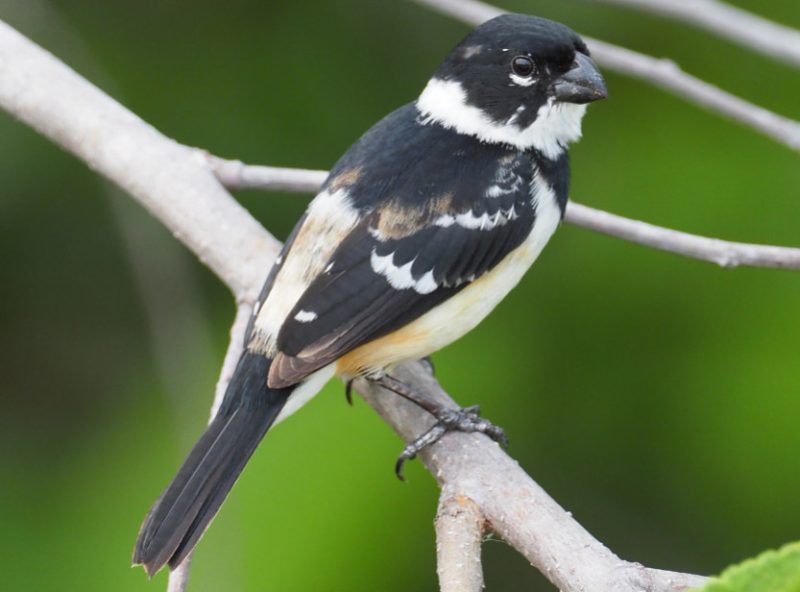
Morelet’s Seedeater (Sporophila morelleti) in North and Central America exhibit black, white, and yellow hues. Males sport dominant black plumage, while females are primarily brown. Despite their name, they consume insects, fruits, and seeds, as well as various plants and grasses.
Found in Texas, Mexico, Guatemala, and Nicaragua.
Steller’s Sea-Eagle
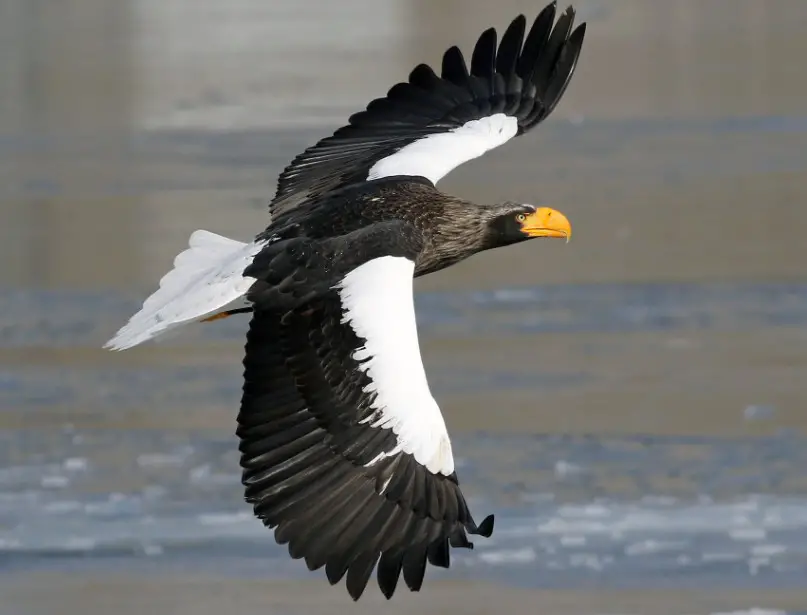
The Steller’s Sea-Eagle (Haliaeetus pelagicus) is a formidable predator, showcasing black, white, and brown plumage. Females, larger than males, can exceed 3 feet in size. Preferring seafood, it primarily feeds on fish like salmon but will also prey on smaller water birds when fish is scarce.
Found in Japan, China, Korea, and Russia.
Manx Shearwater
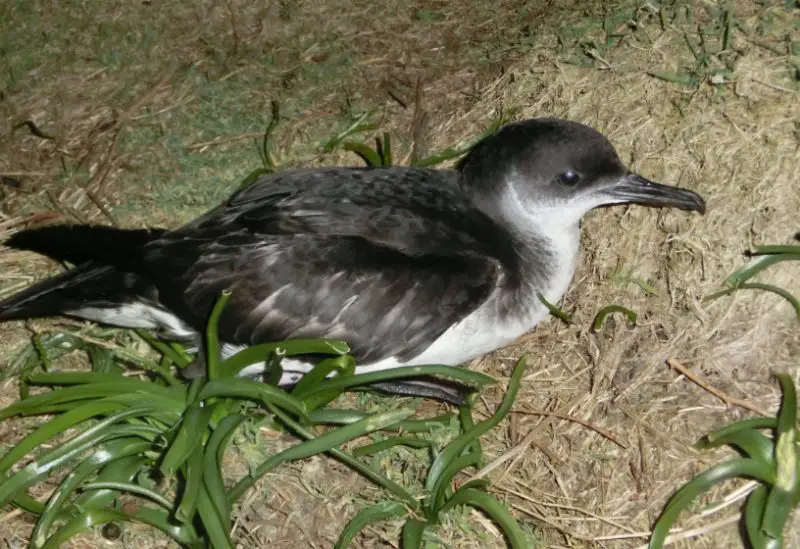
Manx Shearwaters (Puffinus puffinus), South American seabirds, sport distinctive black and white plumage. Rarely sighted, they primarily dwell in the ocean, diving for food or snatching prey from the water’s surface. Their diet consists of small fish and crustaceans.
Breeding colonies can be observed along coastlines in Northern Europe, Eastern Canada, and Eastern South America.
Nazca Booby
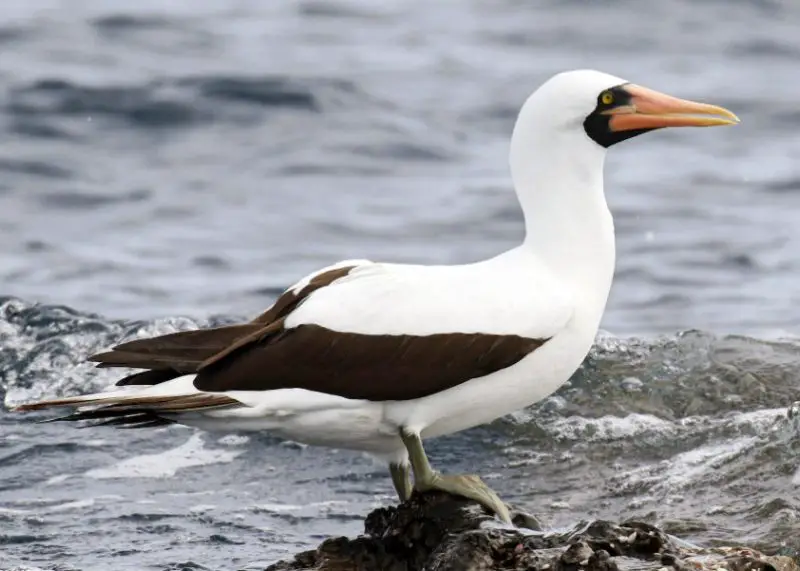
The Nazca Booby (Sula granti) is distinguished by its black and white plumage and striking orange beak. Found in Central American waters, down to Colombia, they prey on small ocean fish. Breeding occurs in this region, with nests typically located on cliffs to deter predators.
Their distribution includes Baja California, Mexico, the Galapagos Islands, Ecuador, and Colombia.
Bridled Tern
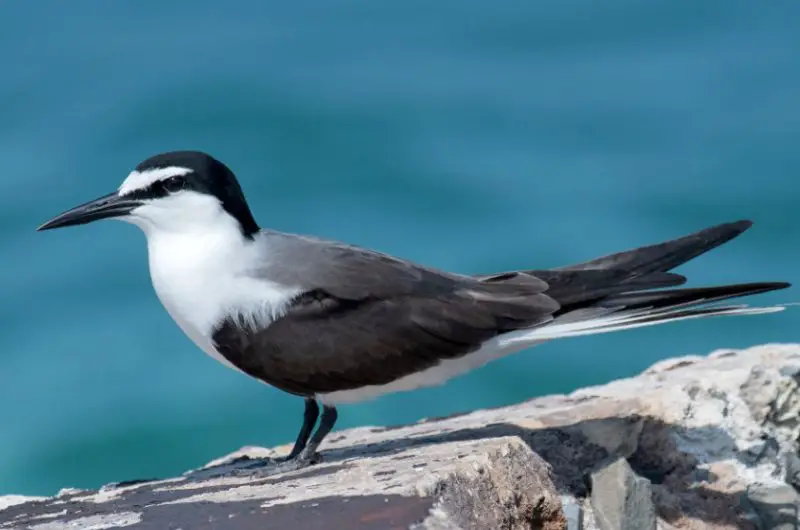
The Bridled Tern (Onychoprion anaethetus), reaching up to 12 inches, exhibits a predominantly black, white, and gray plumage with black legs. They reside in colonies within tropical and subtropical regions, favoring oceans, seas, and coastal areas.
Rarely found inland, they are distributed across the Gulf of Mexico, Central America, the Arabian Peninsula, the Indian Subcontinent, and Oceania.
Least Auklet
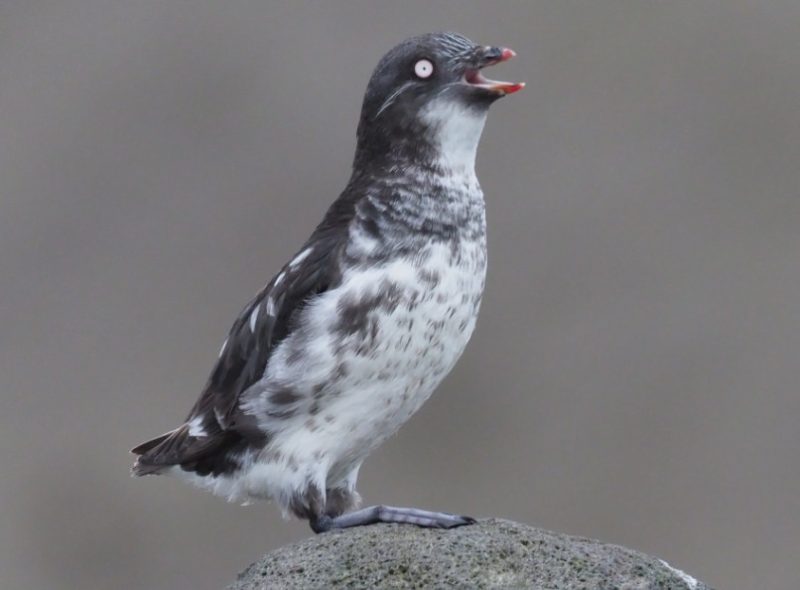
Least Auklets (Aethia pusilla) primarily display gray and white plumage, transitioning to black and white during breeding. They feature black wings and heads, contrasting with white bellies. Feeding on aquatic invertebrates like zooplankton, they soar over water-rich regions for prey.
These colonies are commonly found in rocky coastal areas. They are distributed across Alaska and the Arctic.
Black Noddy
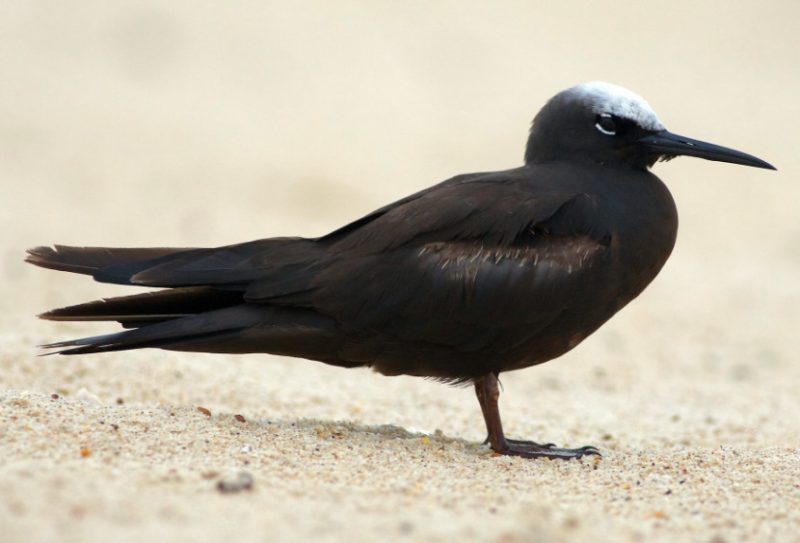
The Black Noddy (Anous minutus) is characterized by its mostly black plumage, accented by a white crown and long black beak. Unique breeding behaviors, including head nodding during courtship, contribute to its name.
Found in tropical and subtropical regions across the Atlantic and Pacific Oceans, it comprises multiple subspecies. As opportunistic feeders, they primarily consume fish and squid.
American Three-Toed Woodpecker
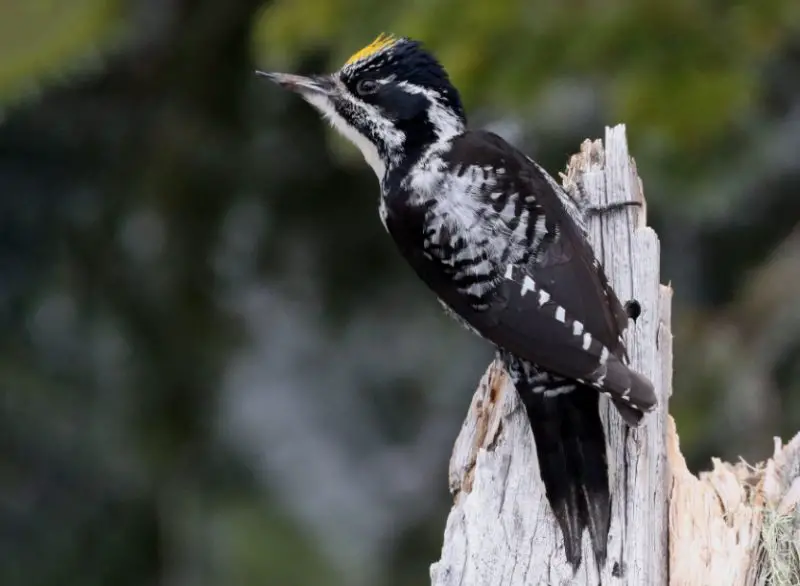
The American Three-Toed Woodpecker (Picoides dorsalis) inhabits remote Northern Canadian forests, featuring predominantly black and white plumage. Males are distinguished by yellow or yellow-orange crowns atop their heads.
They are primarily resident birds, with only the northernmost populations migrating south for winter. Their range includes Alaska, Canada, and the Northwestern US.
Sabine’s Gull

Sabine’s Gulls (Xema sabini) exhibit a striking mix of black, white, and gray plumage, with gray heads that can darken to black during breeding. Typically coastal, they measure up to 13 inches and have diverse diets. Known for long-distance migrations, they travel from their northern habitats to warmer African regions.
They are found across North America, South America, Europe, and Africa.
King Eider
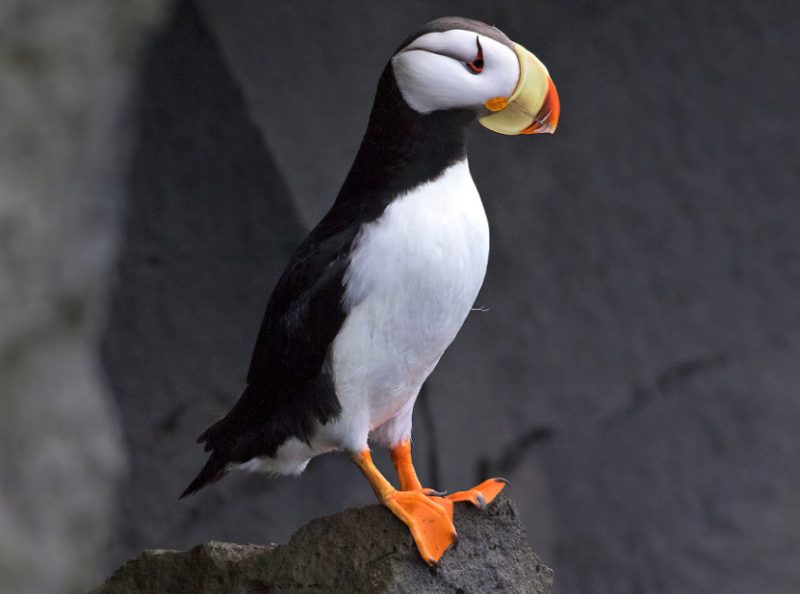
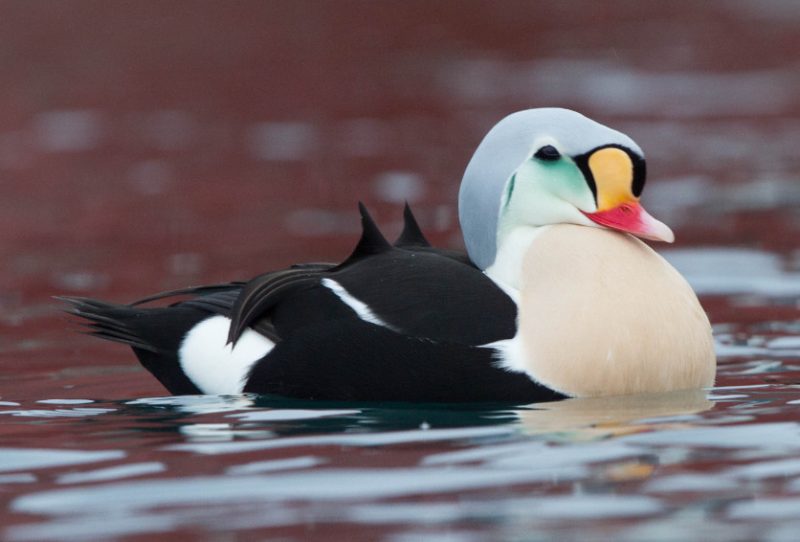
The King Eider (Somateria spectabilis) males boast striking black and white bodies, complemented by gray-blue and green heads with yellow and red beaks. Females display brown hues, while juveniles transition from gray to black and white plumage. These sea ducks breed in tundra habitats and inhabit lakes and ponds, predominantly feeding on invertebrates.
They are found in Northern Canada, Greenland, Iceland, and Northern Russia.
Horned Puffin

Horned Puffins (Fratercula corniculata) exhibit distinctive black and white plumage with yellow-orange bills. They are prominent in the North Pacific, known for their unique flight style. Utilizing high vantage points, they leap before taking flight or may run before liftoff.
These birds favor rocky beach habitats and feed on invertebrates and small fish.
Pomarine Jaeger
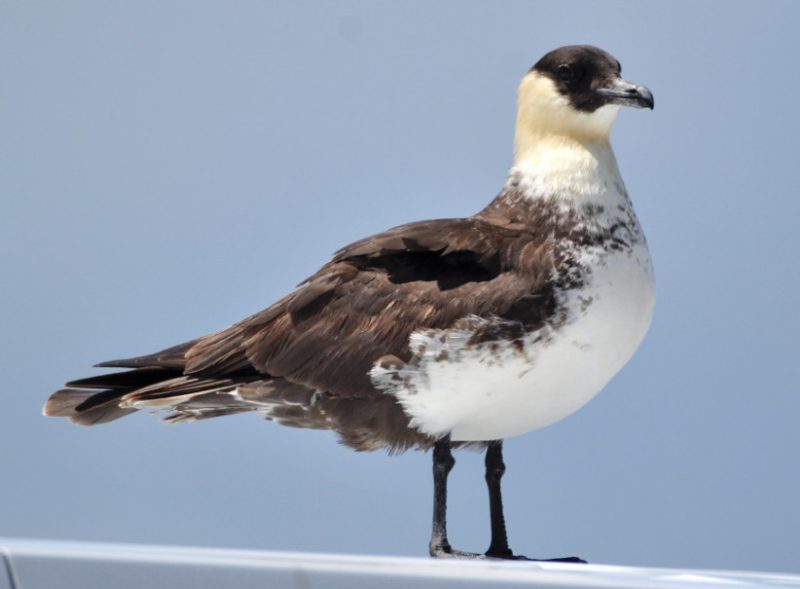
The Pomarine Jaeger (Stercorarius pomarinus) displays black and yellow-white plumage and can reach sizes of up to 26 inches. Found worldwide, they nest in Arctic regions and primarily breed in the Northern part of their range before migrating South.
These seabirds are omnivorous, consuming fruit, seeds, and carrion. They overwinter in South America and Africa.

